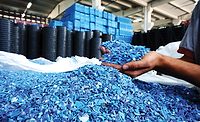2017 Raw Materials and Chemicals Roundtable
Industry leaders in the raw materials and finished adhesives markets share their thoughts on this complicated but vital aspect the industry.




What effects do you think the Trump administration will have in the future for supplies and/or suppliers of raw materials/chemicals?
Eric Post, K-FLEX Global Sales Director, Emerald Performance Materials:
We would expect to see increases in petrochemical spend based on policy under the current U.S. administration with, for example, the executive order to progress the Keystone Pipeline. Demand for toughened structural adhesives, fusion-bonded epoxy coatings and other protective coatings used in pipeline applications will likely increase beyond what we would have already expected, as they play a critical role in ensuring hydrocarbons can be safely transported, minimizing the risk of failure due to environmental effects such as corrosion and impacts.
Lex Reynolds, President, Reynolds Glue:
It is still a little too early to tell at this point because we are early into Trump’s term, but if we can get beyond all of the noise from the left, I am very optimistic that his impact will be very positive for all of manufacturing, particularly in the U.S. Implementing long-overdue tax reform and cutting back on the incessant regulation requirements will be good for all of us and will hopefully create more opportunities for all workers. I believe taking a second look at our trade deals will also be important to the chemical industry because many of these deals favor our competitors and, if you really delve into all of the facts, you will see that America is really at a disadvantage compared to many, as evidenced by the trade imbalances with a number of countries. Trade is good, as long as it is fair for all.
Finally, despite all of the negative connotations from different areas, I do feel a sense of optimism that I have not felt particularly over the last eight years, and many with whom I speak feel the same way. Hopefully Mr. Trump and his team can get down to doing what needs to be done and get away from the pettiness of arguing such things as how many attendees he had at his inauguration and how many electoral votes he garnered during the election. Focus on getting the job done and making sure you do your due diligence before making major announcements so that there is no room for argument from the other side.
Chris Sheeren, Partner, Huron Capital:
In the near-term: Coming out of the gates in 2017, raw material suppliers are starting to raise prices. This trend is consistent from suppliers across the board—from chemical feedstock to steel cans—and was largely expected in early 2017 before Trump took office.
In the longer-term, we would anticipate a reduction in some government regulations, making life easier for manufacturers. However, anyone conducting business internationally would be impacted by new trade policies, and that impact is very difficult to assess at this time.
Merger and acquisition activity among raw materials/chemicals companies has again picked up in the adhesives and sealants industry. What affect do you see this having on the industry and how business is done?
Post:
The adhesives market is nothing if not highly competitive, and a robust M&A climate is being driven by manufacturers looking to increase their capabilities for an increasingly global market and enhance their position for key segments. As manufacturers pick up companies that complement and extend their existing technology portfolio, they also increase their capability to develop new solutions for niche areas. As a result, consolidation has had a very positive impact on innovation in recent years, as manufacturers look to capitalize on emerging markets, expand their range of offerings for existing markets and hone their competitive edge.
Reynolds:
We just had a major announcement recently with H.B. Fuller buying Wisdom, and I believe if you ask anyone in our industry they will agree this is the best thing that could have happened to our industry. The key question is now: how will Fuller treat this business? Can this industry put a stop to the self-inflicted commoditization or do we continue to act irresponsibly? It is beyond time for everyone to get on board with righting this ship.
In general, our industry needs some consolidation and it needs it soon. There is too much capacity out there and too many large customers who, along with willing suppliers, are totally destroying the ability of the industry to make fair profits. In my 40 years, I have never seen such chaos and I certainly hope it ends soon because it is hurting all of us, suppliers and manufacturers alike. Why someone in these organizations doesn’t take note of their shrinking margins, I will never understand. We aren’t talking about rocket science, but common sense.
Sheeren:
To the extent that we see meaningful consolidation of raw material suppliers, we would expect to see input prices rise over time. From Huron Capital’s perspective, we find the market attractive because of the opportunity for adhesives and sealants manufacturers to differentiate themselves with unique offerings.
How does your company address the constantly changing regulatory/legislative landscape?
Post:
Over the past several years, regulatory bodies worldwide have increased their scrutiny of chemicals used in the manufacture of adhesives and sealants, with a focus on evaluating the safety and potential health effects of chemicals of concern. For example, a push for lower volatile organic compound (VOC) concentrations has resulted in a market shift toward waterborne adhesives in applications where solventborne may have traditionally been used. As materials suppliers, we have worked closely with customers to develop solutions that lower VOCs and eliminate materials of concern, such as phthalates and polyfunctional aziridine, a crosslinker associated with mutagenicity.
The regulatory landscape is constantly changing, with this increased scrutiny enforced on not only new chemicals, but also on existing chemicals. Programs such as the EPA’s New Chemicals program target newly developed molecules, while the European Union regulation concerning the Registration, Evaluation and Authorisation and Restriction of Chemicals (REACh, EC 1907/2006) is aimed at evaluating both new and existing substances. Within the U.S. market, new uses of existing substances are evaluated under Section 5(a) of TSCA through the Significant New Use Rules (SNURs), which have been made even more stringent with recent TSCA modernization efforts. As a result, new technology developments that drive increased performance and address unmet needs have become more challenging to bring to market due to the increased time, costs and resources needed. New materials must be compliant with appropriate regulations regarding manufacture and sales in each and every region.
Remaining in compliance is a never-ending challenge, particularly with differing testing and information requirements in various regions. We have focused on working closely with customers to stay ahead of the curve with global regulations, addressing requirements up front as a key part of the process of evaluating new development opportunities. We attempt to stay on top of the constantly changing regulatory landscape through multiple avenues. This includes participating in trade association regulatory working groups, direct active monitoring of regulatory agency publications and initiatives, and the use of industry intelligence publications.
Reynolds:
Over the last couple of years, we have been slammed with requests to fill out regulatory forms, questionnaires and studies that, in some cases, you need a Ph.D. to answer. They are long, ludicrous and stupid, to put it bluntly. Many have nothing whatsoever to do with our processes or our products. I oftentimes wonder who in the world is coming up with this stuff and if it will ever end. We have two people who now address these requests and, if the regulations keep growing, we may have to hire another person.
I am hopeful that Mr. Trump will do what he says about cutting the number of regulations that are smothering American manufacturers, particularly the smaller businesses like our own. It’s crazy.
Sheeren:
We need to make sure that we are on top of the state-specific regulations in all of the regions in which we compete. The rules in California can be very different from those in other states. Trade shows and journals are a great way to keep current.
How is the fluctuating global economy impacting raw materials and chemicals used in the adhesives and sealants industry?
Post:
For the next few years, the U.S. chemical industry will continue to be positioned for strong growth due to feedstock cost advantages and new capacity coming on line. For example, increasing shale gas exploration in the U.S. is one factor contributing to increased availability of ethylene, and as a result, vinyl acetate monomer, a vital feedstock for adhesives that has been impacted by issues with production and availability in recent years.
Reynolds:
In our world, it’s all about supply and demand. As the economies of the world slow down, raw materials become more readily available and prices moderate, as we have seen over the last year. Conversely, the opposite is true when the worldwide economy heats up and prices rise, as we witnessed a few years ago. In the “old days,” it always seemed to be more about rising oil and gas prices; though they certainly have an impact, recent history has been more about supply and demand and the imbalance thereof.
There are a number of plants coming on line over the next several years that will certainly impact raw materials/chemicals, both with regards to availability and pricing. It will be interesting to see what happens.
What factors are driving innovation for raw materials/chemicals producers?
Post:
Many major segments, such as packaging, construction and transportation, are growing rapidly, along with a global economy continuing to rebound from the recession and an increasing middle class and infrastructure in developing regions. As demand grows, so too have end use needs. For example, in response to increased demand for convenience-based goods, we have seen innovation surrounding new packaging designs for food and beverage and other consumer items. Tougher structural adhesives that resist extreme environmental conditions are increasingly replacing conventional metal fastenings, especially in transportation, automotive, and aerospace, where lightweighting to improve fuel economy is a consistent and critical driver for new material innovation. There is also increasing global opportunity in emerging markets, such as clean energy.
Another important consideration is the push toward waterborne adhesives and all-around lower volatility over solventborne adhesives, as well as the replacement of materials that could pose a threat to human health, such as phthalates, especially problematic in the EU, and polyfunctional aziridine crosslinkers. In the U.S. construction market, the Green Building Council’s LEED version 4 has led toward more transparency, calling for companies to share chemistry information. The Asia-Pacific region is also beginning to come more in line with North America and Europe in terms of regulation of materials.
Reynolds:
There are a number of factors that can and should drive innovation in our industry over the next few years. Eliminating the use of solvents and other “suspect” chemicals like those found in the production of polyurethanes should be a motivating factor to those seeking alternatives. Products that offer higher heat resistance and solvent resistance without the use of troublesome raw materials is of great interest to many. Competing technologies to metallocene chemistries so that there are alternatives in the marketplace for compounders to utilize is something that should drive innovation. Lightweighting in automobiles is another area that the OEMs are interested in that can help drive innovation. And, finally, as our industry has unfortunately followed the Wal-Mart model of low prices, developing lower-costing raw materials should drive innovation for all of us.
Sheeren:
Regulatory changes and the end customers’ increasing demand for environmentally friendly chemicals continue to drive innovation. ASI
For more information, visit www.emeraldmaterials.com, www.reynoldsglue.com or www.huroncapital.com.
Any views or opinions expressed in this article are those of the participants and do not represent those of ASI, its staff, Editorial Advisory Board or BNP Media.
Looking for a reprint of this article?
From high-res PDFs to custom plaques, order your copy today!








